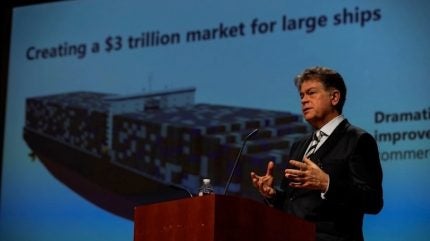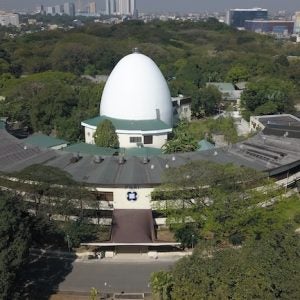
The recent New Nuclear for Maritime Houston Summit, held at the Asia Society Texas Centre in Houston, and sponsored by UK-based start-up Core Power, saw a number of ambitious plans revealed for nuclear shipping. Core Power CEO Mikal Bøe in his keynote presentation announced that the company will develop a US-anchored maritime civil nuclear programme that will bring floating nuclear power to market by the mid-2030s.
The programme, Liberty, will lay the foundation for the use of nuclear power in the civil maritime sector. It will encompass modular construction of advanced fission technology and create the regulatory and supply chain frameworks necessary to enable this technology to be rolled out worldwide.
“The Liberty programme will unlock a floating power market worth $2,600bn, and shipyard construction of nuclear will deliver on time and on budget,” Bøe said. “Given that 65% of economic activity takes place on the coast, this will allow nuclear to reach new markets.”
The first part of the Liberty programme will see the mass production of floating nuclear power plants (FNPPs). The expertise gained in rolling out FNPPs on a large scale will pave the way for the second part of the programme, which will focus on developing nuclear propulsion for civil ships. Bøe said mass production is possible because the Liberty programme will employ advanced nuclear technologies. “Core Power’s Liberty programme will deliver resilient energy security for heavy industry and ocean transport,” he added. “In doing so, it will revolutionise the maritime sector and transform global trade.”
Core Power said FNPPs will be produced in shipyards on a modular production line, using well-established shipbuilding processes and leveraging an already-skilled workforce. They will be manufactured as power barges that can be moored at ports and coastal locations, as well as larger-capacity generation units anchored further offshore. A fleet of FNPPs can be mass produced and towed to customer locations without complex site preparations, while a central yard carries out commissioning, maintenance, refuelling, and waste management. The Liberty programme will employ advanced nuclear technologies, such as molten salt reactors.
“The Liberty programme envisions opening the orderbook for FNPPs in 2028 and reaching full commercialisation by the middle of the next decade,” Core Power said. The company will choose a location in the USA to build the initial manufacturing yard for FNPPs. The second phase of the programme will focus on developing the supply chain and workforce. The third phase will see the development of business operations models and creating the manufacturing base.
Core Power also plans to aid the development of international safety and security standards by working together with the International Maritime Organisation and the International Atomic Energy Authority to create a civil liability convention for nuclear-powered ships.
Also addressing the Summit, which attracted 230 delegates, was American Bureau of Shipping (ABS) Chairman & CEO Christopher J Wiernicki, who emphasised the game-changing potential of new nuclear technology in transforming commercial shipping.
“New nuclear technology is a global decarbonisation solution and a commercial shipping disruptor. There is no net zero by 2050 without nuclear,” he said. Nuclear technology can be a game changer, with potential to reshape the economics of shipping as well as vessel operations.
“Not only does it offer zero carbon operations but higher power with faster transit speeds, increased cargo storage due to the elimination of fuel storage and it unlocks the potential for reverse cold ironing where the vessel powers the port,” he noted. It also eliminates the need for frequent bunkering.
Wiernicki also insisted that new nuclear can be highly competitive. “The economics are compelling over the life of a vessel. When you account for fuel differentials, the cost of compliance and residual value, it costs roughly the same as fossil options, only with zero carbon operations. And it gets much more attractive when compared to the high cost of green fuels.”
Nevertheless, significant challenges remain. Wiernicki said unlocking nuclear’s potential will require a new public-private partnership and a fresh commercial model. Insurance models must adapt, regulatory gaps must be addressed, global licensing standards developed, and crew training must be a key investment. “The ultimate boundary condition for this technology will be safety, and we need to ensure we engage and educate the public about the advanced safety performance of these new reactors,” he concluded.
During the Summit, South Korea’s HD Korea Shipbuilding & Offshore Engineering (HD KSOE) unveiled a nuclear-powered container ship model utilising small modular reactor (SMR) technology.
HD KSOE, a subsidiary of HD Hyundai, said the new model features enhanced economic efficiency and safety by incorporating actual equipment and safety design concepts. Unlike conventional ships, nuclear-powered vessels do not require engine exhaust systems or fuel tanks. The company has optimised the space previously occupied by large engine room equipment to accommodate additional containers, enhancing economic efficiency. It has also applied a marine radiation shielding system using a double-tank method with stainless steel and light water to ensure safety.
In collaboration with global energy technology company Baker Hughes, HD KSOE has also applied a supercritical carbon dioxide-based propulsion system, improving thermal efficiency by about 5% compared with existing steam-based propulsion systems.
HD KSOE said it plans to establish a marine nuclear demonstration facility at its Future Technology Test Centre in Yongin, Gyeonggi Province, to verify safety designs. “HD KSOE is strengthening cooperation not only with major classification societies but also with international regulatory bodies to establish international regulations necessary for the commercialisation of nuclear-powered vessels,” said Park Sangmin, Head of HD KSOE’s Green Energy Research Lab, during a session at the Summit. “Starting with the land-based SMR reactor manufacturing project, we aim to develop a marine nuclear business model by 2030.”
In October 2023, a design for a floating offshore nuclear power barge from HD KSOE and Kepco Engineering & Construction (Kepco E&C) received approval in principle from ABS. Project collaborators included ABS, HD KSOE, Kepco E&C and the Liberian International Ship & Corporate Registry. The floating SMR barge is intended to serve as offshore power generation for remote communities and island electrification.
In January 2024, a memorandum of understanding was signed between Lloyd’s Register, Zodiac Maritime, HD KSOE and Kepco E&C for the development of nuclear-propelled ship designs, including bulk carriers and container ships. Under the joint development project, HD KSOE and Kepco E&C will provide designs for future vessels and reactors while Lloyd’s Register will assess rule requirements for safe operation and regulatory compliance models.
HD KSOE in February 2024 announced plans to develop an SMR for use in shipping in cooperation with the Core Power and US Southern Company and TerraPower. In November 2022, HD Hyundai invested $30m in TerraPower. The reactor to be jointly developed centres around TerraPower’s Molten Chloride Fast Reactor (MCFR) design.






